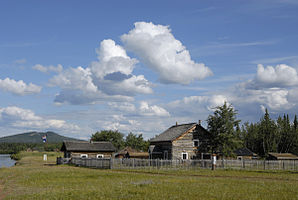Fort Selkirk
| Fort Selkirk | ||
|---|---|---|
 Historic buildings in Fort Selkirk |
||
| Location in Yukon | ||
|
|
||
| State : |
|
|
| Territory : | Yukon | |
| Coordinates : | 62 ° 46 ′ N , 137 ° 23 ′ W | |
| Residents : | 0 (status:) | |
Fort Selkirk is a former trading post in the Canadian Yukon Territory at the confluence of the Pelly and Yukon Rivers .
The Selkirk First Nation has been at home here for a long time, so the site is also of importance as an archaeological site.
Early history
Finds show that the region around the later fort has been used by Indians for around 11,300 years and the area at the river mouth for at least 7,000 years . This area was the border between the ice-free Beringia and the ice sheet, which covered more than half of North America. The oldest find is a tool made from caribou antlers. Until about 8000 BC Most of the glaciers had melted in the 3rd century BC and the landscape was transformed into a lake area that existed for more than two millennia. The tundra was increasingly taken over by forest, the tools of the so-called Northern Cordilleran Culture are only found sporadically.
Around 5000 BC In the 2nd century BC, the large projectile tips, which were the only remains, were replaced by composite tools made up of several parts. So you just had to replace the blunt or broken stone tips, which were now much smaller ( microblades ). A larger site was discovered around 3 km above Fort Selkirk. At this point, blades made of ten different types of stone were found, dating from 5000 to 3000 BC. Were manufactured.
Around 3000 BC There was another change in stone tool technology, as stones notched sideways were now inserted into other materials, and microblades disappeared. Numerous wood and antler tools for fur processing appeared. At this time, seasonal migrations during the year can also be detected, for example using fish traps. It is possible that the onset of salmon migrations, which moved up the Yukon and its tributaries to spawn, led to a change in lifestyle. One of the most important sites for this era, known as the Northern Archaic , is an area near Pelly Farm , above Fort Selkirk.
After the worst volcanic eruptions around 850 AD in the area of the White River on the border with Alaska, the central Yukon was covered by a huge ash shower, which is likely to have led to an ecological catastrophe. The culture that can be recognized afterwards is the so-called Late Prehistoric . Now copper appears in weapons technology and in the manufacture of tools, a material that originated in the White River area. Many of the villages and camps that the first Europeans to the region saw can be traced back to around 1000. Often times the tools are so similar to the youngest that only the elders of the Selkirk First Nation can tell them apart.
Fort of the Hudson's Bay Company
Robert Campbell was the first European to reach the area in 1843 when he was going down the Pelly. He was an employee of the Hudson's Bay Company and established a trading post nearby in 1848, which was moved to its present location in 1852. He referred to the Selkirk as "Gens de Bois", people from the forest. They even named themselves after a fish camp near Victoria skirt as Thi Tsach'an .
The Tlingit feared because of the settlement of the Hudson's Bay Company for their traditional trade relations with the Athapaskan First Nations and destroyed the fort in the same year.
40 years later it was rebuilt and developed into an important supply center on the Yukon.
Historic site
When the Klondike Highway , which bypasses Fort Selkirk, was built in the middle of the 20th century and the Yukon lost its importance as a waterway, the post was abandoned.
Many of the buildings have now been rebuilt. The Fort Selkirk Historic Site is proportionally owned by the Selkirk First Nation and the Tourism and Culture Ministry of the provincial government. There is no road connection. Fort Selkirk can be reached by boat or plane.
literature
- Fort Selkirk , Yukon Tourism, Heritage Branch, undated
- Greg Hare, Ruth Gotthardt: A Look Back in Time. The Archeology of Fort Selkirk , Whitehorse 1996

